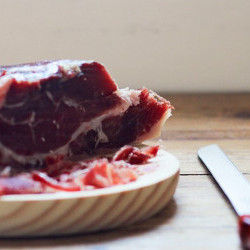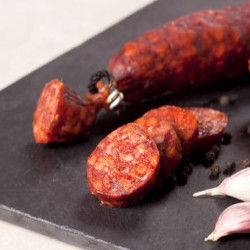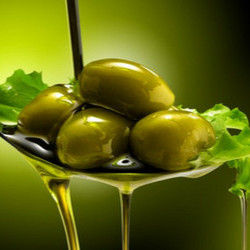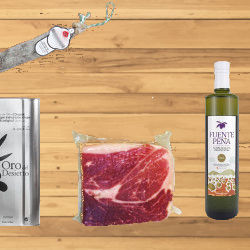HOW TO TASTE A DRY HAM
Tasting dry ham is also a necessary experience, in which we must know all aspects to consider. Not surprisingly, we talk about the elements that lead us to opt for one piece or another: witch will decide our final choice.
Get carried away by a mere glance could be harmful, since all hams at first glance seem maintained and well-made pieces. It is not advisable to rely only on the price, sometimes the value depends on designations of origin, curing process, and weight.
Then, we will know a little more about what we must do to taste a Jamón Ibérico.
1. Look at the fat
Ham fat is an essential element of the product. Hated by many –who not hesitate to remove ostentatiously in each cut- the truth is that it is a needed gustatory complement as well as a key element in the internal structure of the ham. The truth is that it must be present in a right proportion. An excess will lead to the typical phrase ""this ham is all fat."" Although, you must not rely on hams that do not present any fat.
Hence the lance test that experts give to ham, where the fat is located.
Fat is one of the points that supports the curing of the ham, texture and an important part of the characteristic ham flavor resides in the fat.
We differentiate two main types of fat:
External fat
The first pieces of so-called ham lard should have a yellowish tone, which will gradually change to a white or pale pink color. This tonality testifies that the curing process has been the adequate. dry hams who have very white outer fat probably have been “express time” cured and will not have the desired quality. Furthermore, external dry ham fat should have a uniform aesthetic, with no peaks or strange points. The yellowish tone, and its gradual descent to the white or pink, are also proof of a correct fed based on acorns and / or quality fed, a key aspect for the expert.
Internal fat
In the fat present in the inner part of the dry ham, the main tones must be white and pale pink, with shy yellowish reminiscences. Furthermore, their dispersion must be uniform, although we speak of an essential part of the slices: the marbling.
The initial lance test mentioned above is done in part -also serves to discriminate the aroma- to be able to appreciate streaks of color that allow us to know how is the internal fat of the ham. Hence its importance.
2. The ins and outs of the slice. Zones to know
To appreciate appearance and taste of dry ham we must know what aspect it would be desirable to present the slices to the human eye. The Iberian ham comes from the segment of red meat; hence, nobody surprises by its characteristic reddish tones. The color range varies within a range that goes from weak pink to deep purple, deep red being the most present. The cuts present a distinctive bright tone, as a thin layer of fat surrounds them. Consistent marbling with white fat uniform dispersion is usually also a sign of quality.
3. The aroma
Undoubtedly, aroma is one of the most characteristic points of the Jamón Ibérico ham. Smell, which permeates the environment with his marked personality, attracts seasoned consumers of this product. The experts usually use concepts like ""flavor"" or ""bouquet"" to define the union between the taste and the smell of a good Jamón Ibérico. There are even those who argue that having a sligth stale smell is a good sign, although the excess can be unpleasant and not in line with a quality product like Jamón Ibérico dry ham.
4. The salting. Or the right point of salt
In this subsection comes into play the salt of the dry Jamón Ibérico ham in question. All the experts talk about the Jamón Ibérico as a product that combines three different flavors in perfect balance: salty, sweet and bitter. The saltiness has a clear cause: the salting process that the workpiece is submitted during curing. The excess of this element usually marks that the product has not been well cured. Acorns eaten by the animal, meanwhile, mark the sweet taste. The bitter taste – in any case, not very accentuated - is a mixture of the previous two and has some points very similar to the sweet taste. If it is much accentuated it is an additional witness that the curing process has not been the adequate.
Source: http://www.guia-jamon.com/
- Why Iberian ham?
- RACE OF THE IBERIAN PIG
- IBERIAN, YORK AND PARMA HAM DIFFERENCES
- 4 TIPS FOR PRESERVING THE HAM
- HOW TO TASTE A DRY HAM
- BENEFITS OF OLIVE OIL
- OLIVE OIL’S BENEFITS
- OLIVE OIL, WHY EXTRA VIRGIN?
- PREGNANCY AND OLIVE OIL
- HOW TO SLICE A BONELESS DRY HAM
- HOW TO USE A SLICER MACHINE
- ¿Que es una "Dehesa"?
Buy the best spanish Jamon Ibérico ham, sausages, olive oil and meats
Order pata negra online, buy iberian ham in Switzerland, buy spanish serrano ham in Switzerland
Jamón Ibérico dry ham is a type of ham from the Iberian pig, much appreciated in the gastronomy of Spain often considered as an article of haute cuisine and gastronomic luxury. They are a star ingredient in the famous tapas.
Check our pata negra price and jamón iberico ham price here. Choose back (ham/jamón) or front (shoulder/paleta) from pigs reared in Jabugo/Huelva and Guijuelo/Salamanca.
The sausages are classified within the smoked products, and those of the Iberian pig result from a exceptional quality, texture and flavor. Pantanegra-Schinken.ch has selected for you three varieties of Iberian sausage with clearly differentiated characteristics, which will allow you to enjoy of its exquisite variety: Iberian lomo, Iberian chorizo and Iberian salchichón.
Olive oil is considered the cornerstone of the Mediterranean Diet, one of the most Healthy and varied in the world. A good olive oil, is not only capable of enriching with its flavor a great variety of dishes, but that, also, will contribute to your food important nutrients with great value for both your diet and your health.
Beyond the cured Iberian products, there is a great selection of Iberian meats of excellent quality to cook all kinds of tasty and healthy dishes. Minimum 100kg of Iberisches Schweinefleisch per order. Minimum 100kg of Iberian pork mean per order.
Based in Spain, the online spanish specialities shop of PataNegra-Schinken.ch, PataNegra-Jamon.es, PataNegra-Schinken.de, PataNegra-Jambon.fr, PataNegra-Prosciutto.it offer you the possibility to buy high quality Iberian ham from Switzerland, Spain, Germany, France and Italy. Now you have the possibility to delight yourself with products of recognized prestige and D.O. exclusive in Spain.




